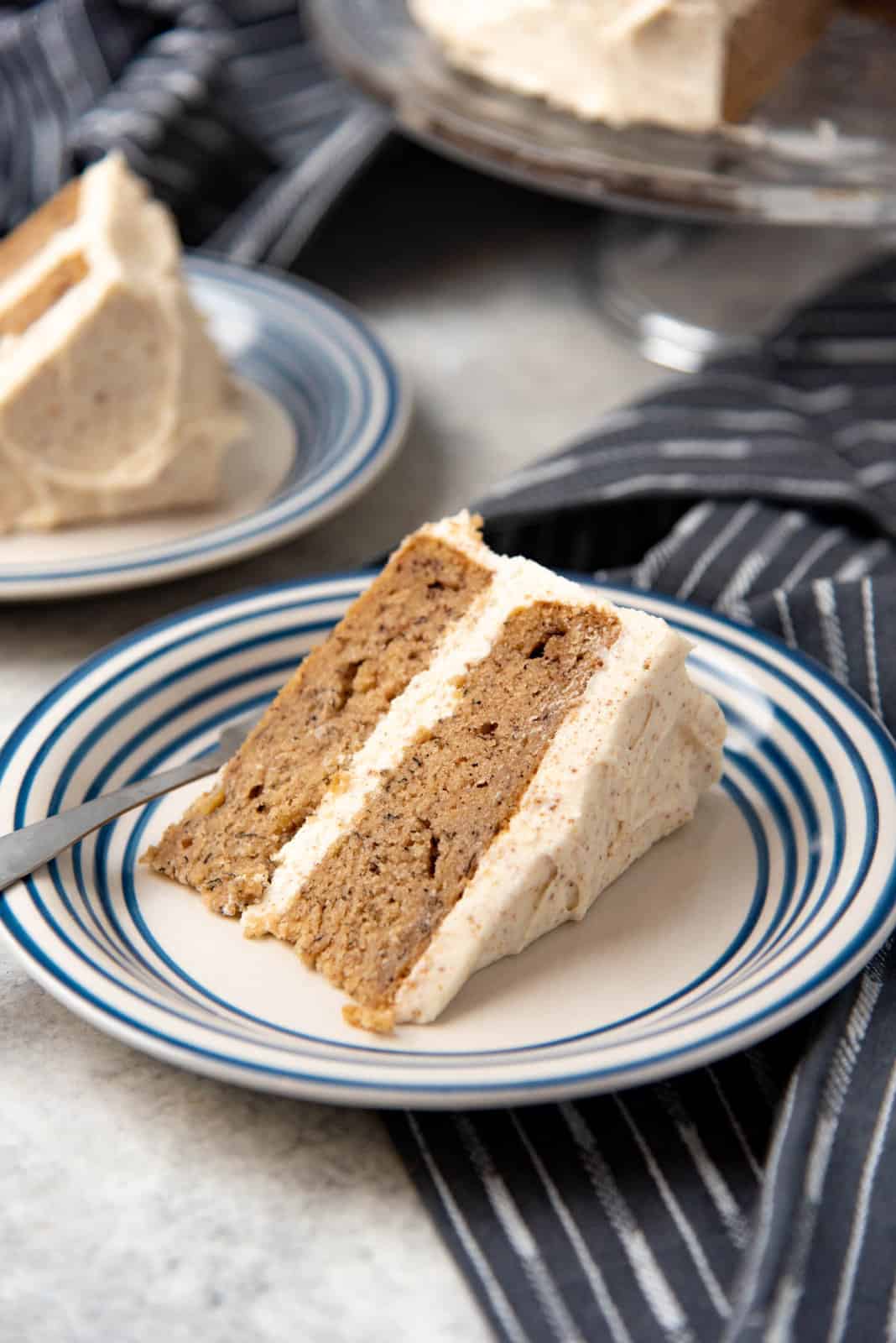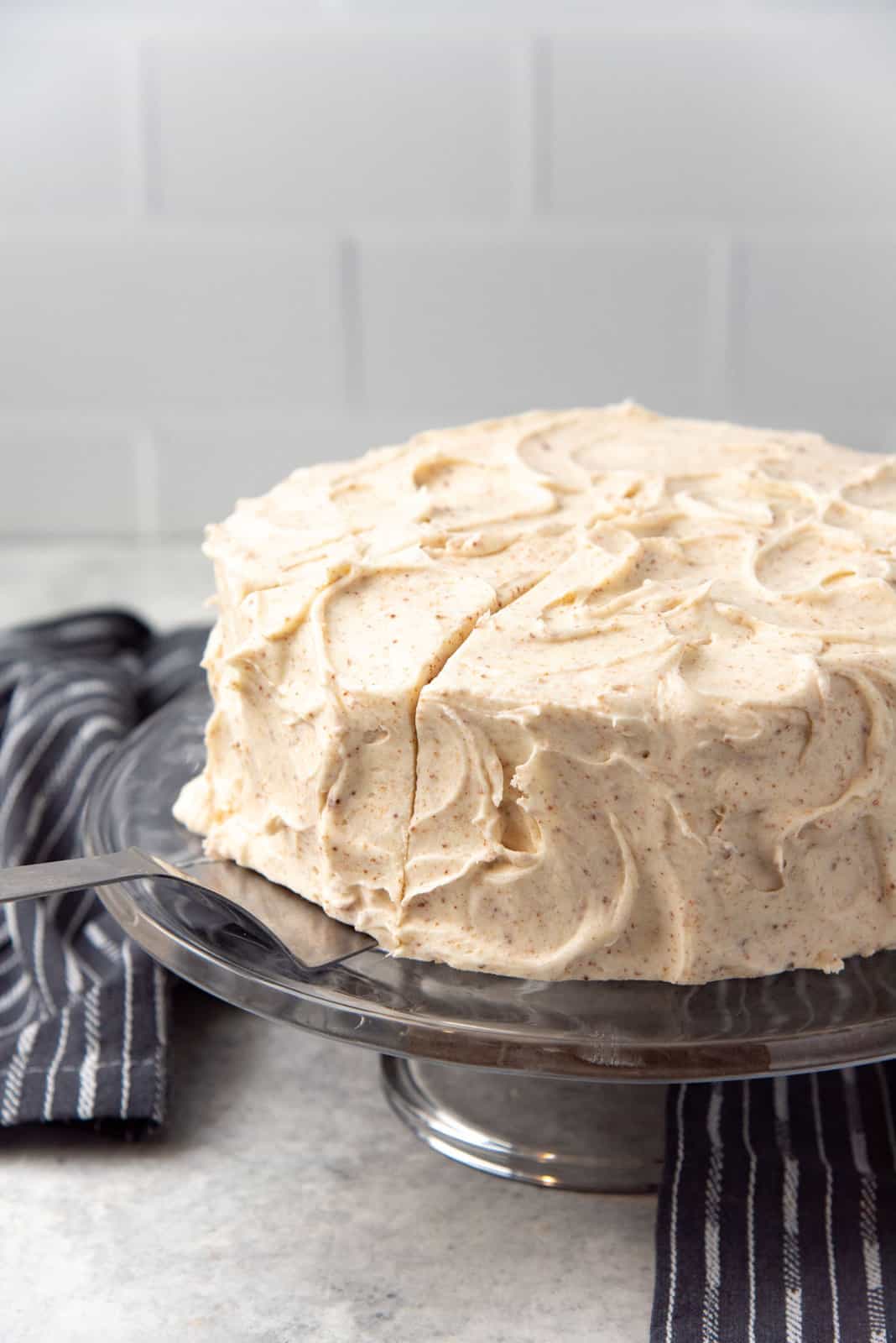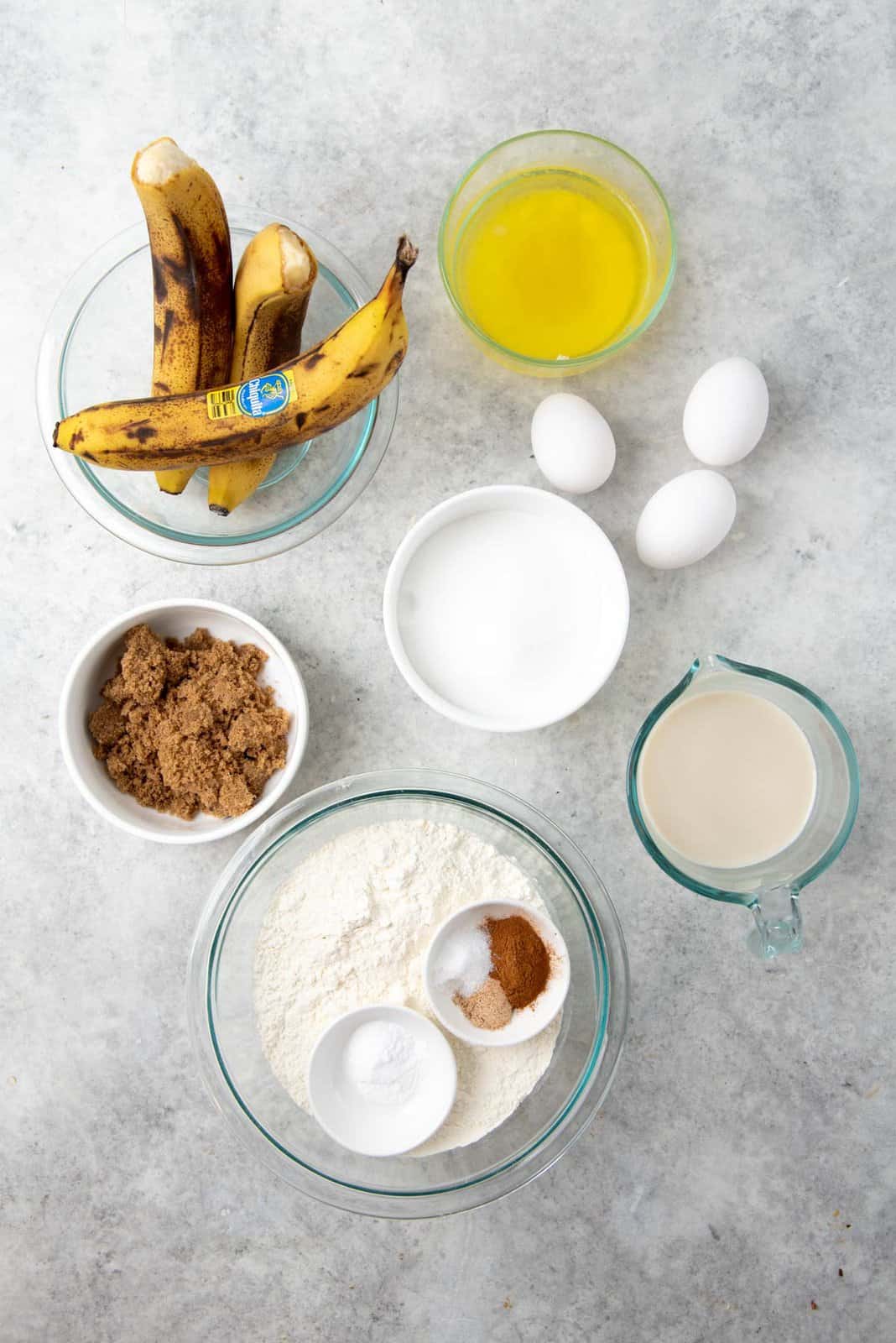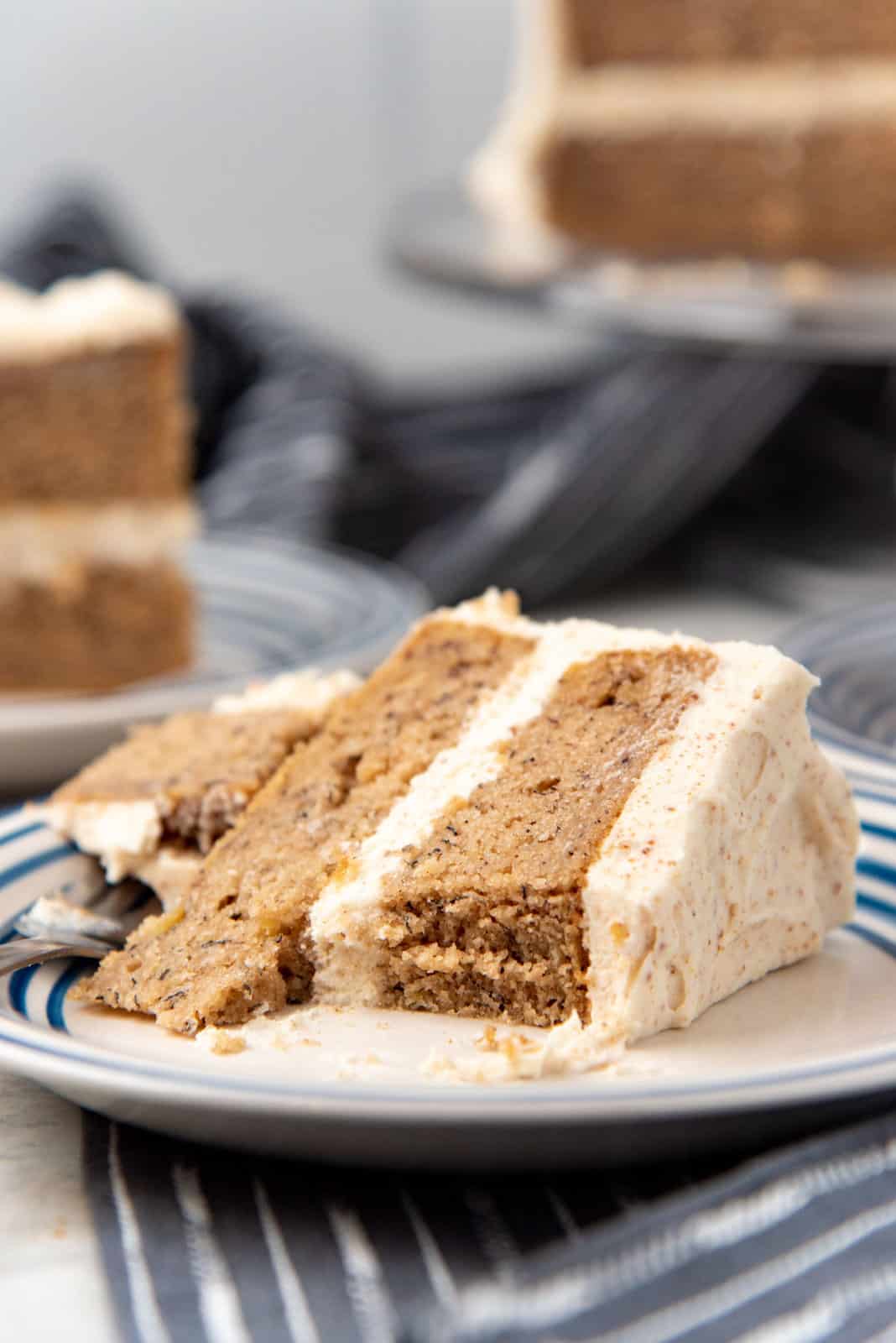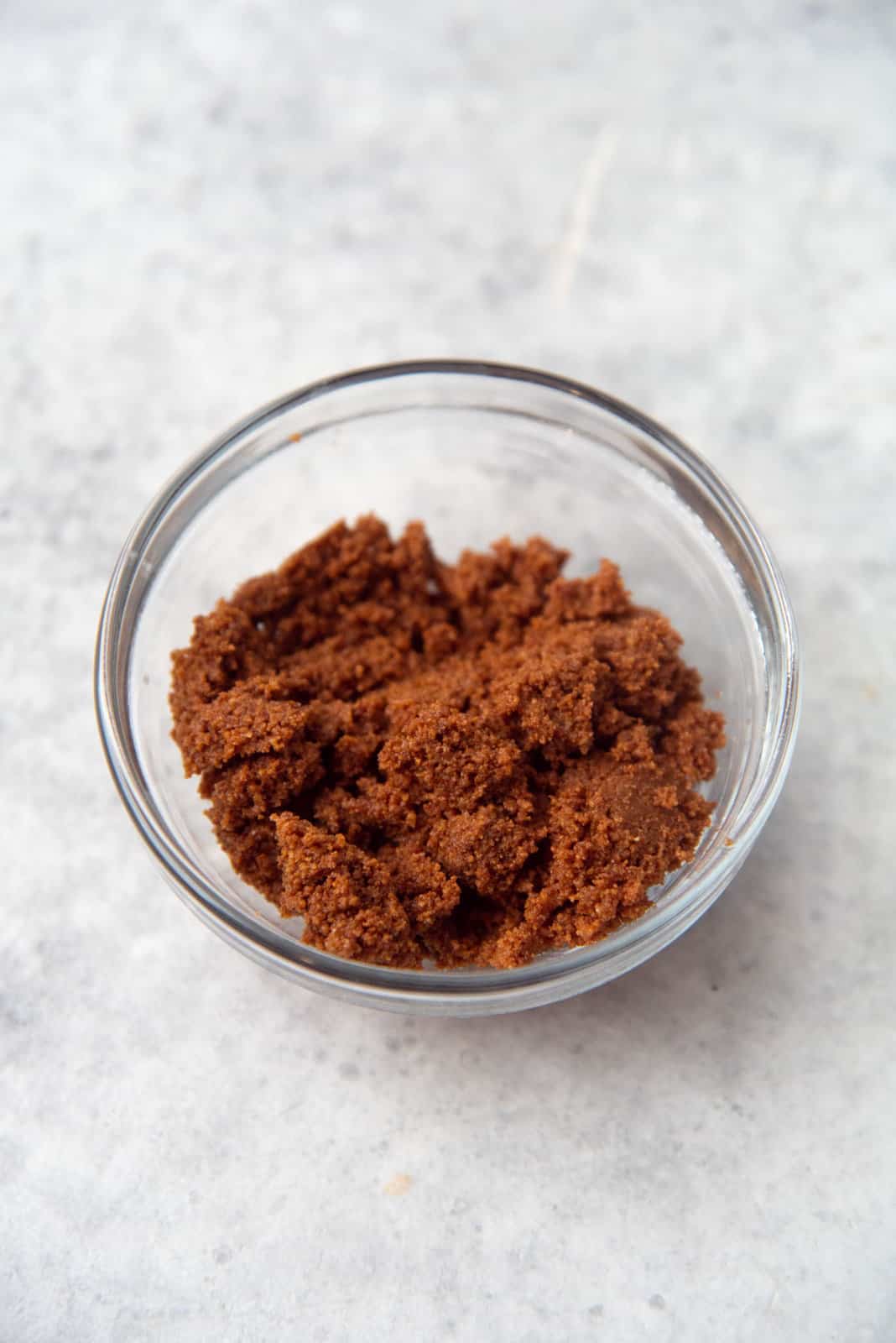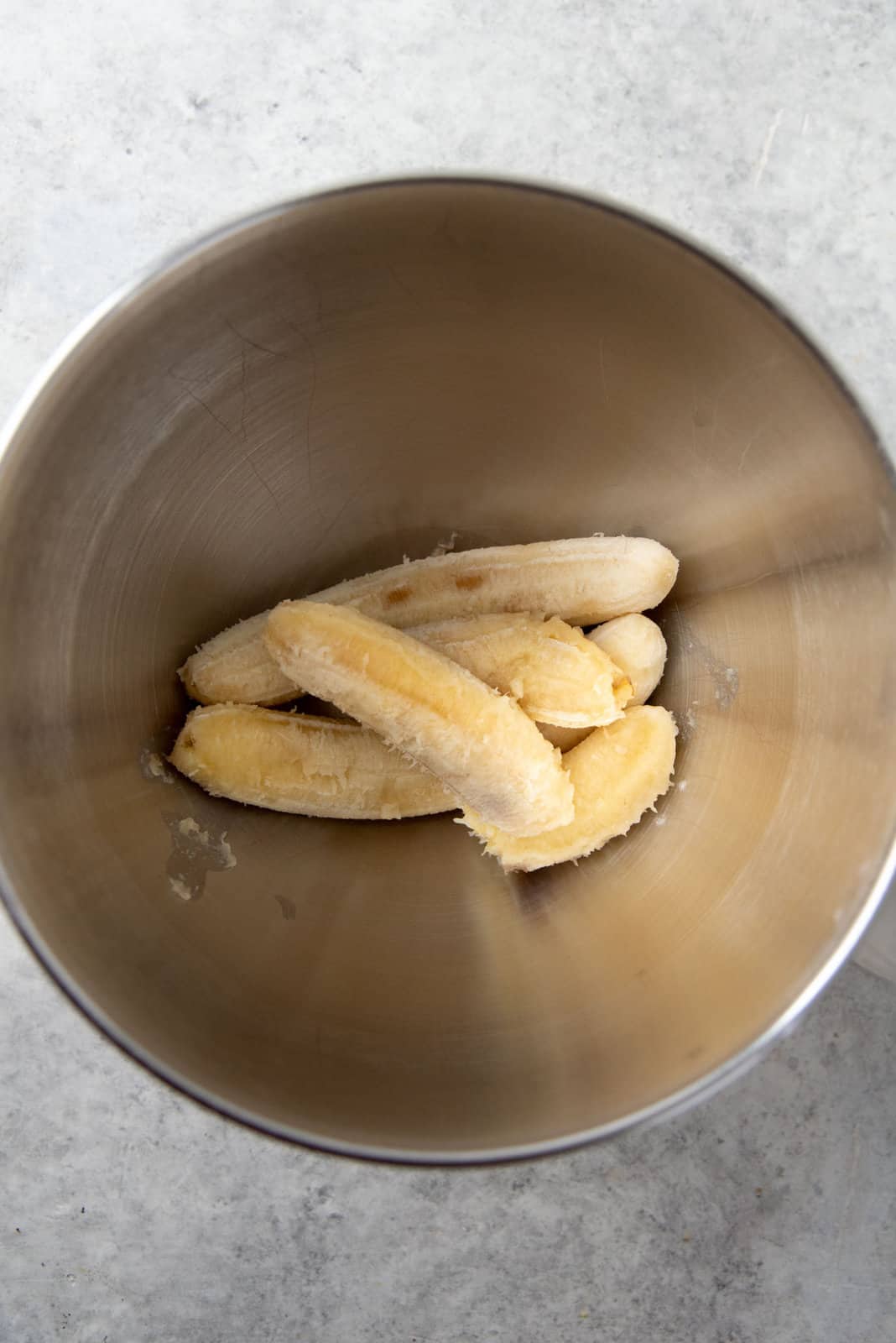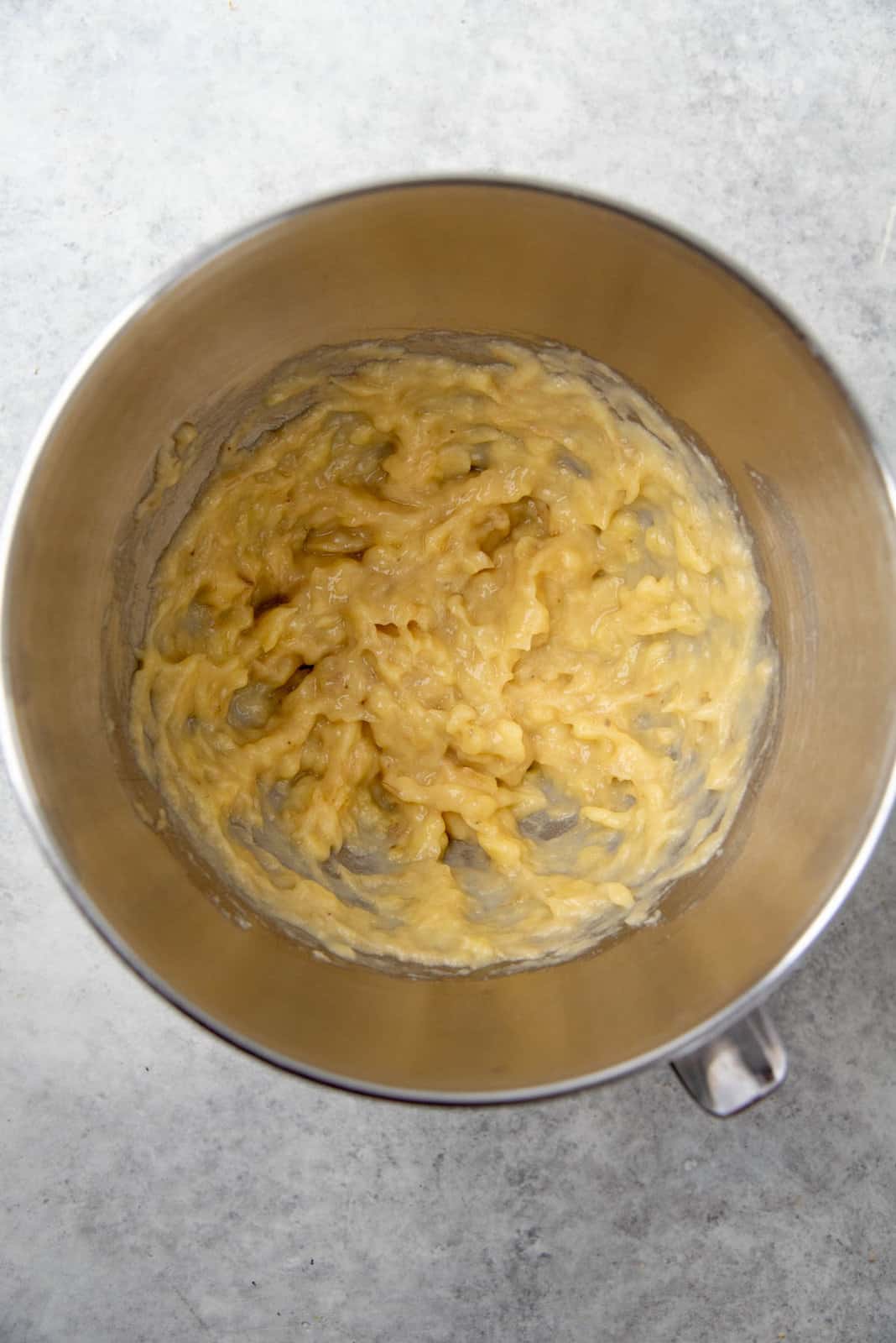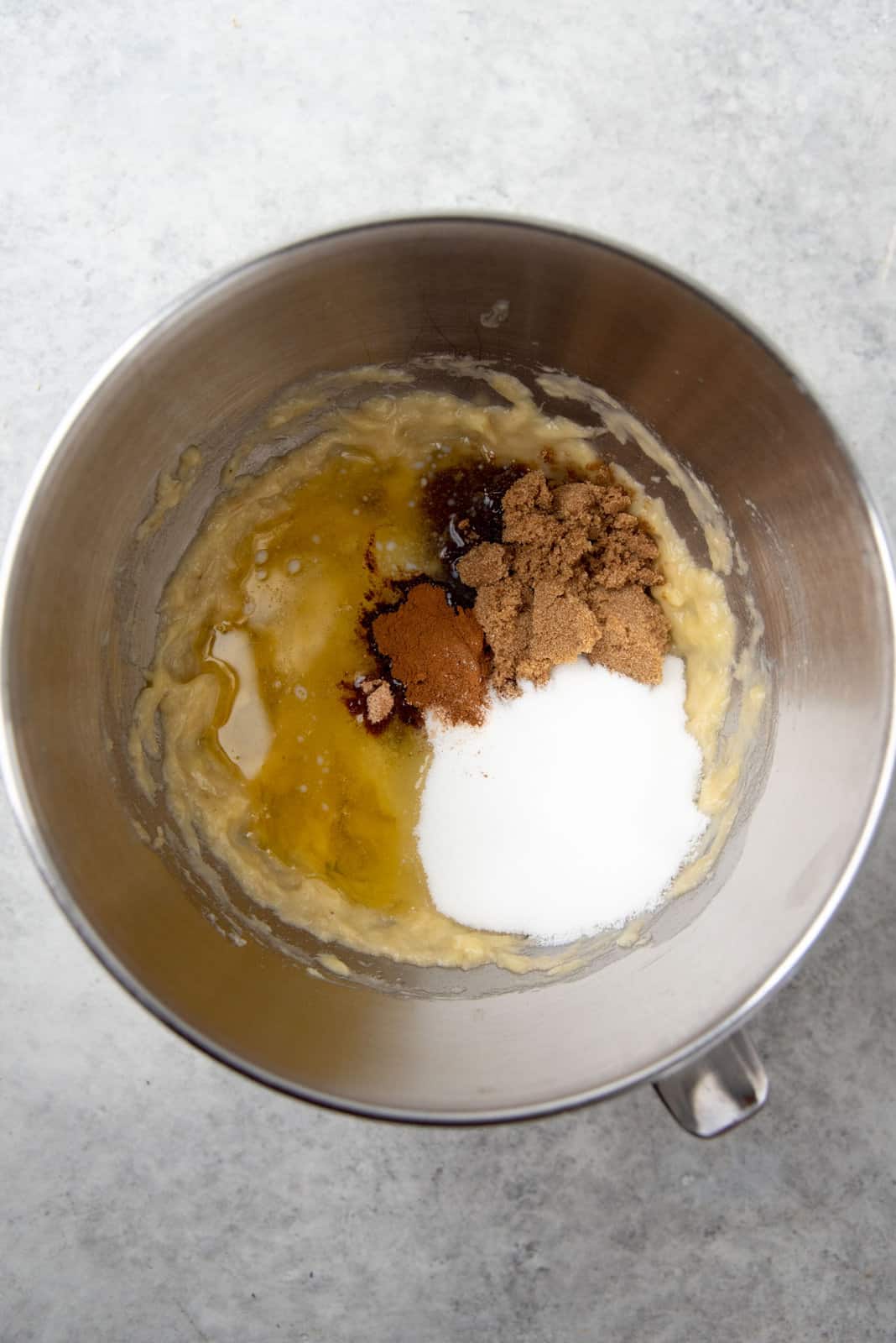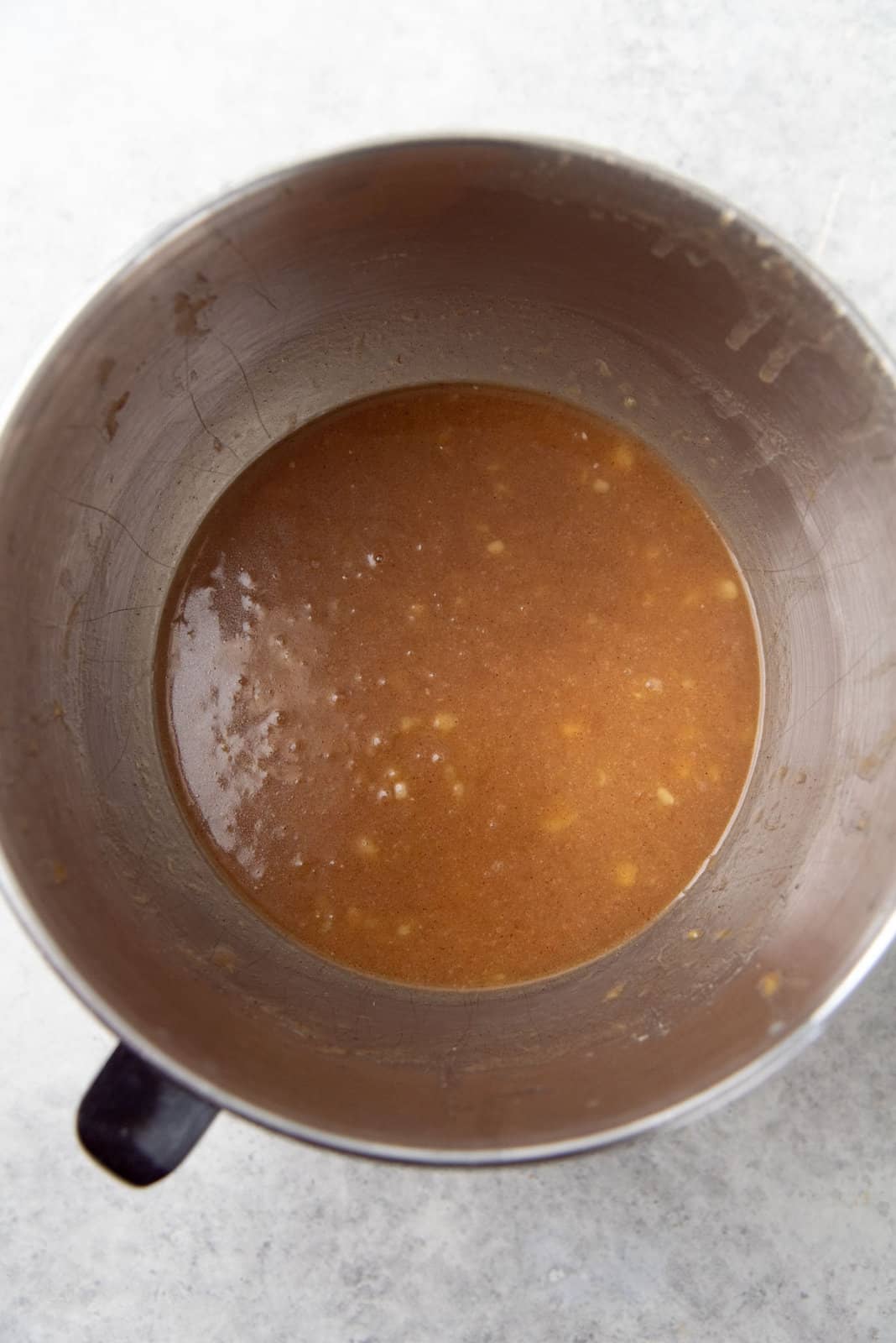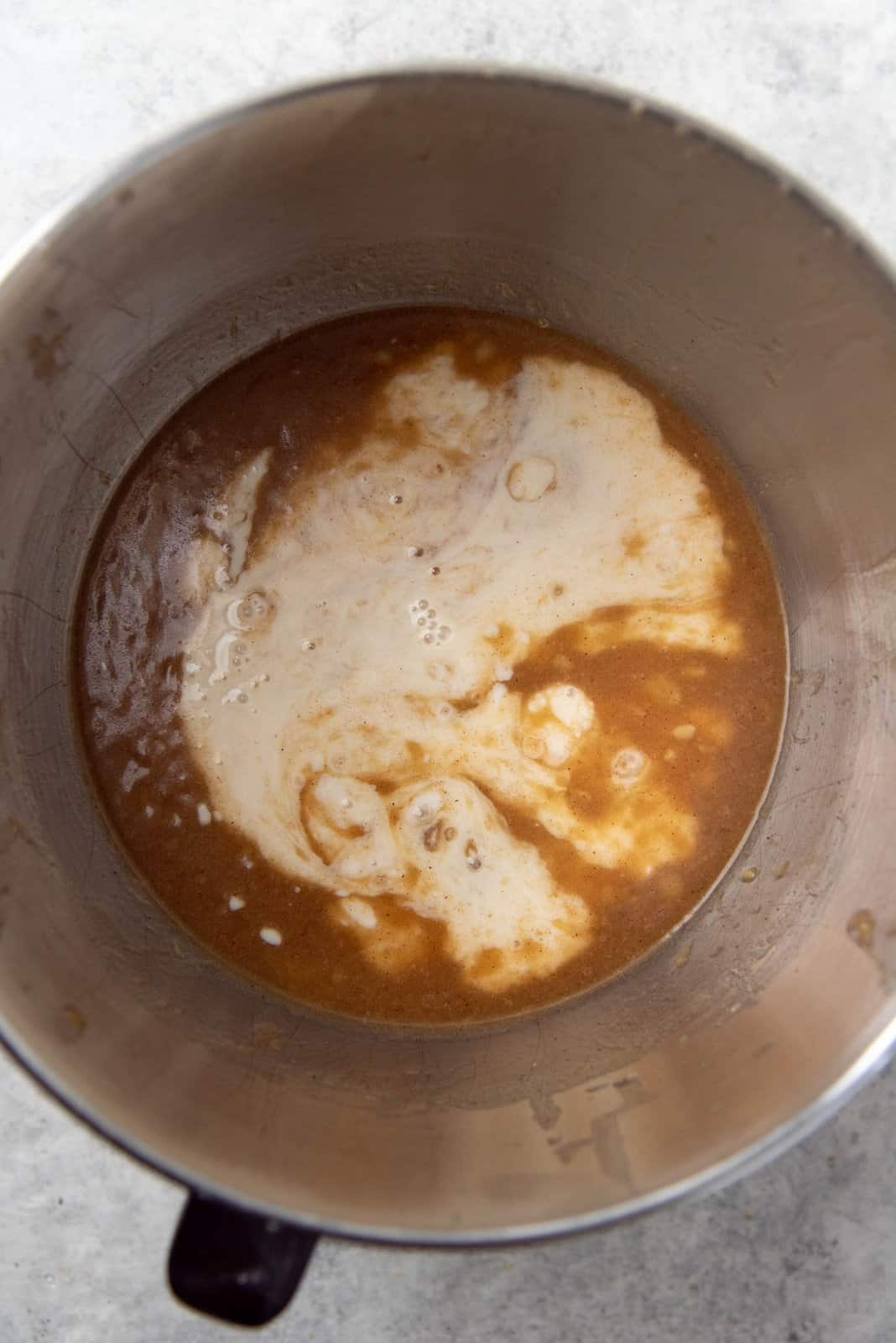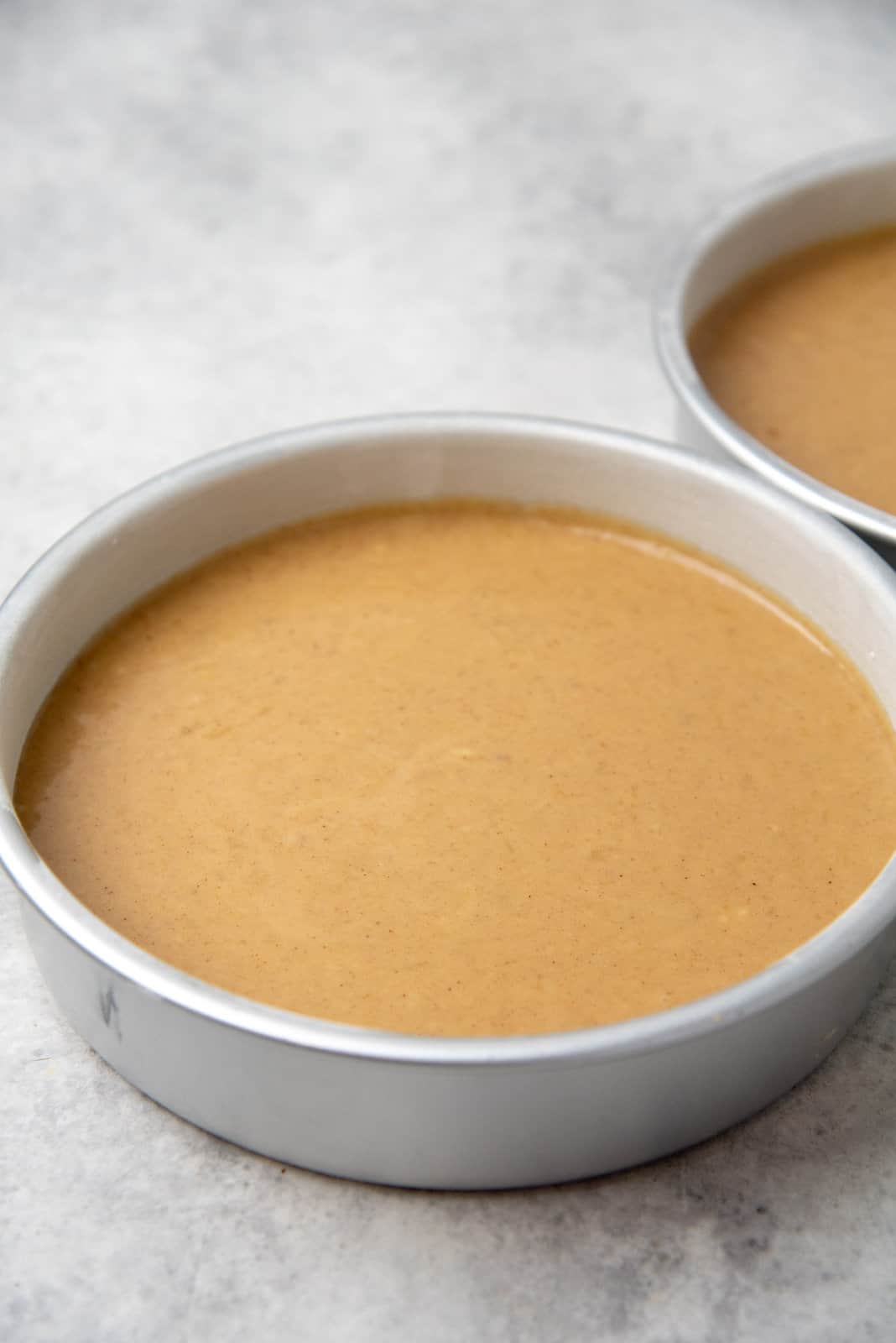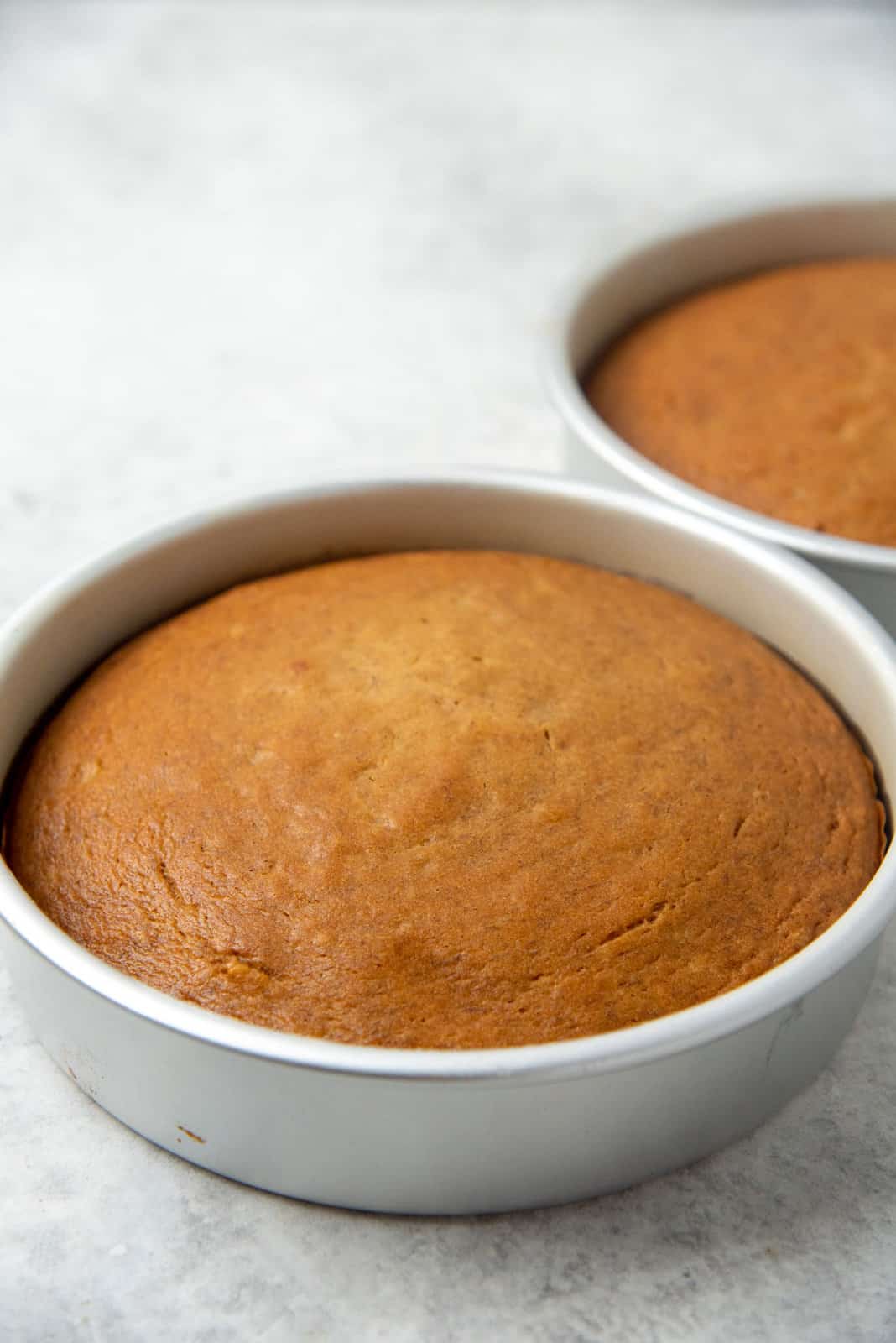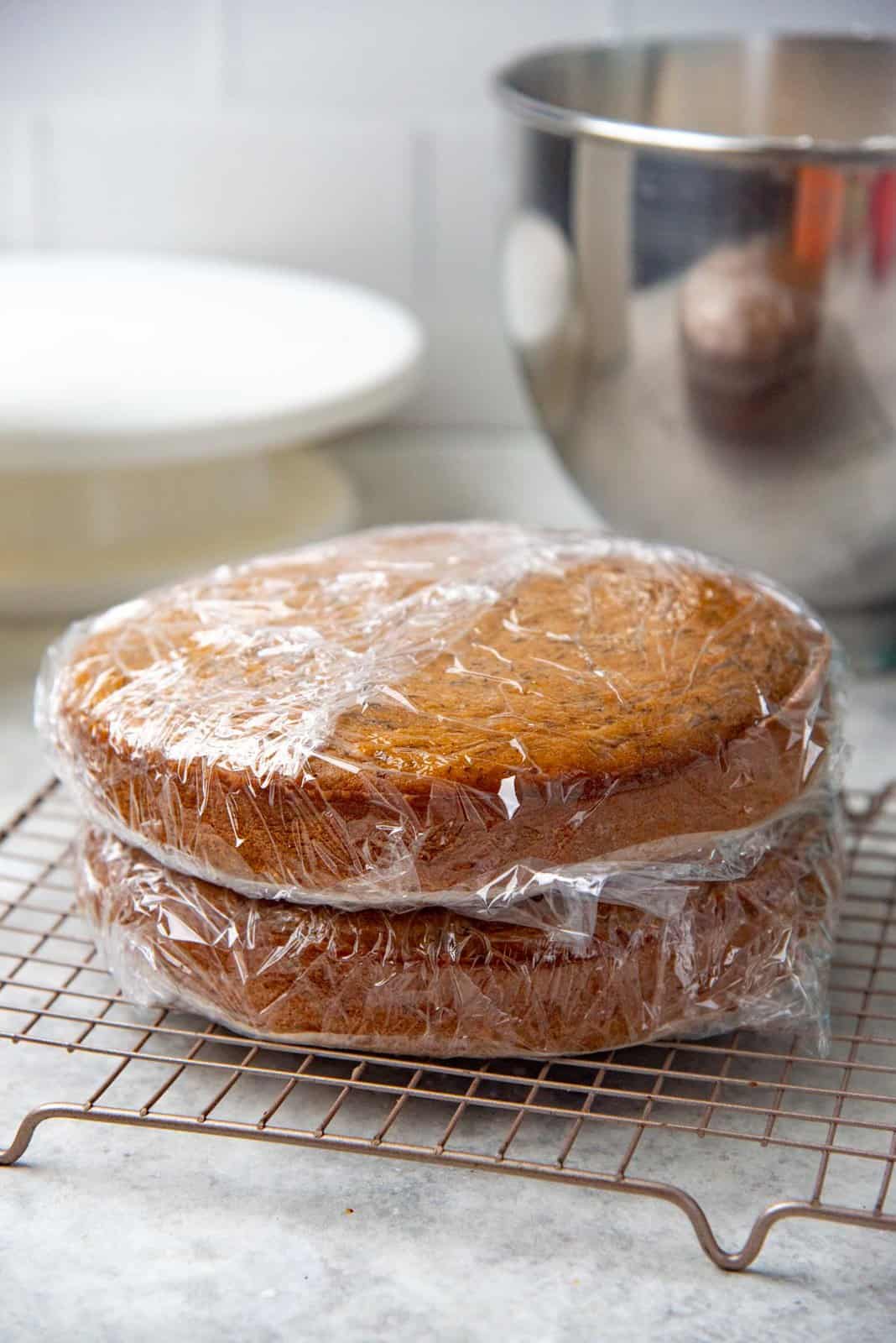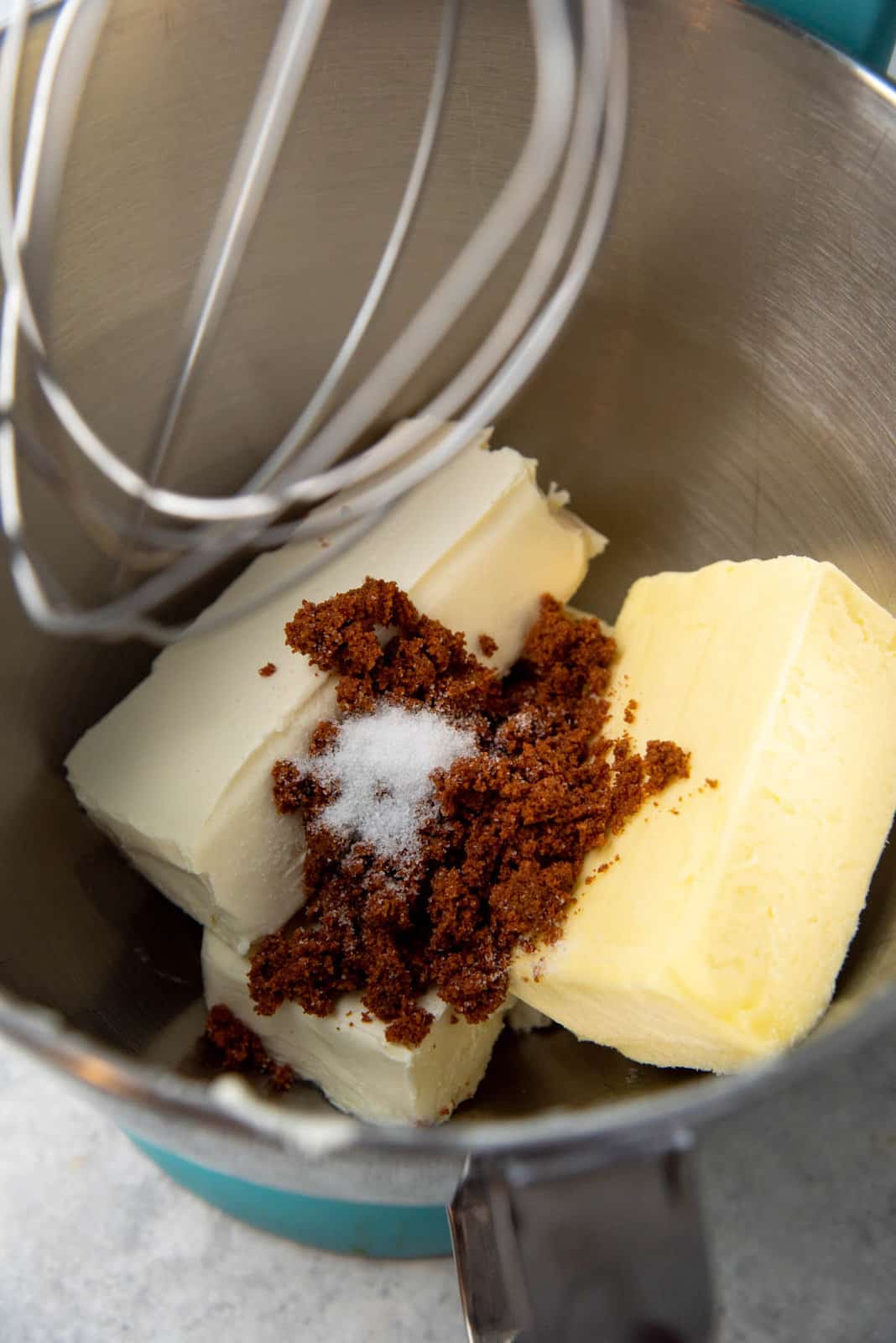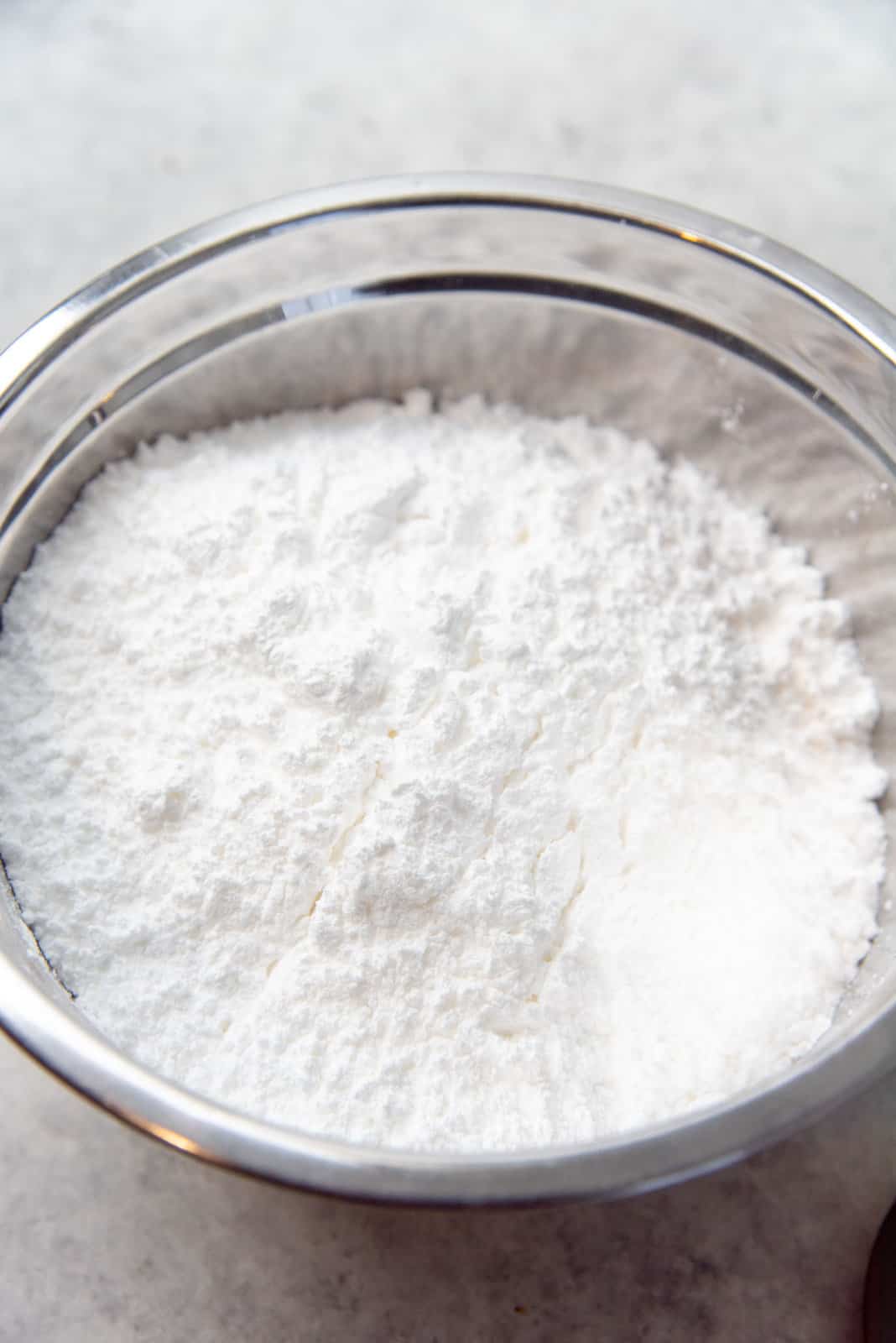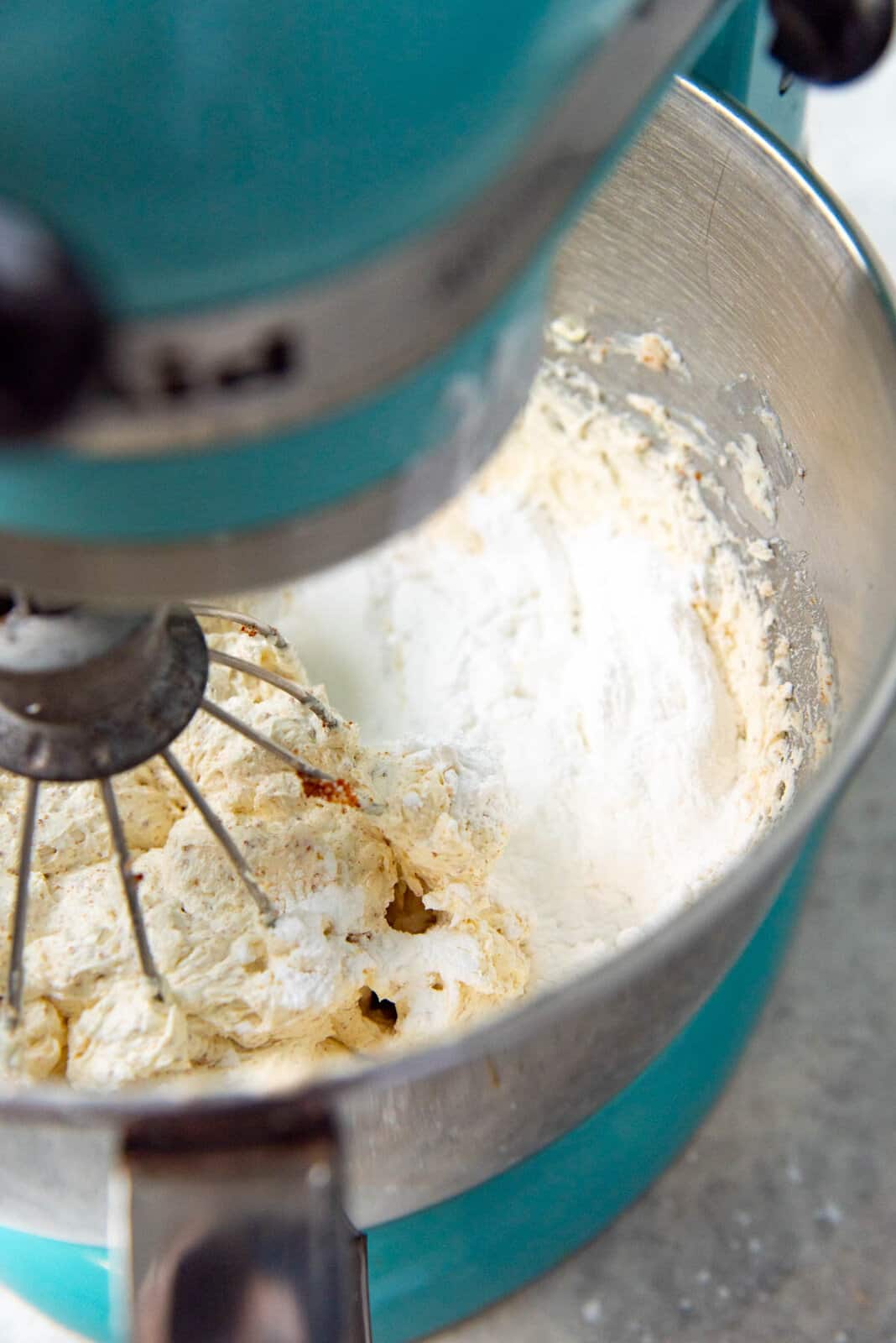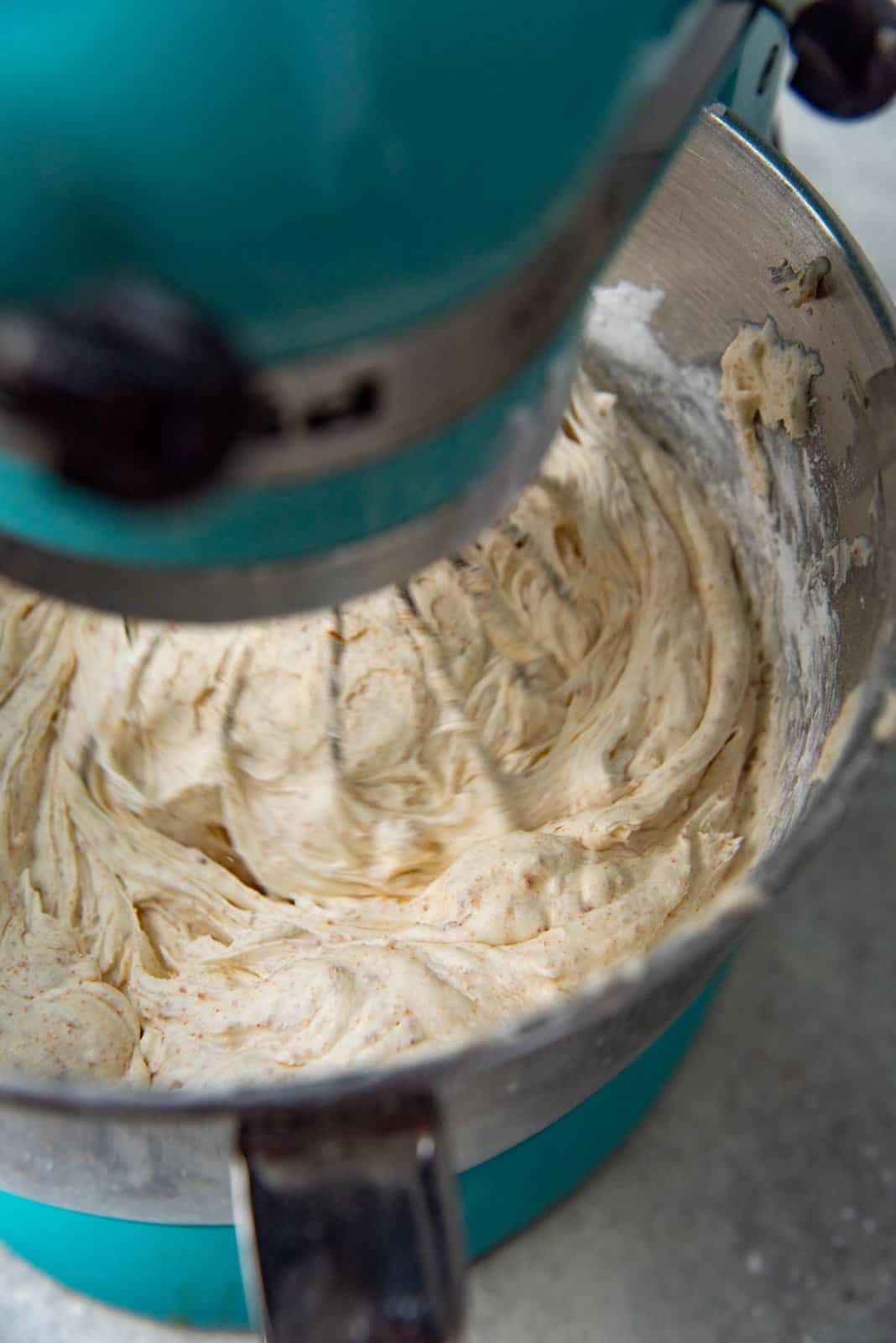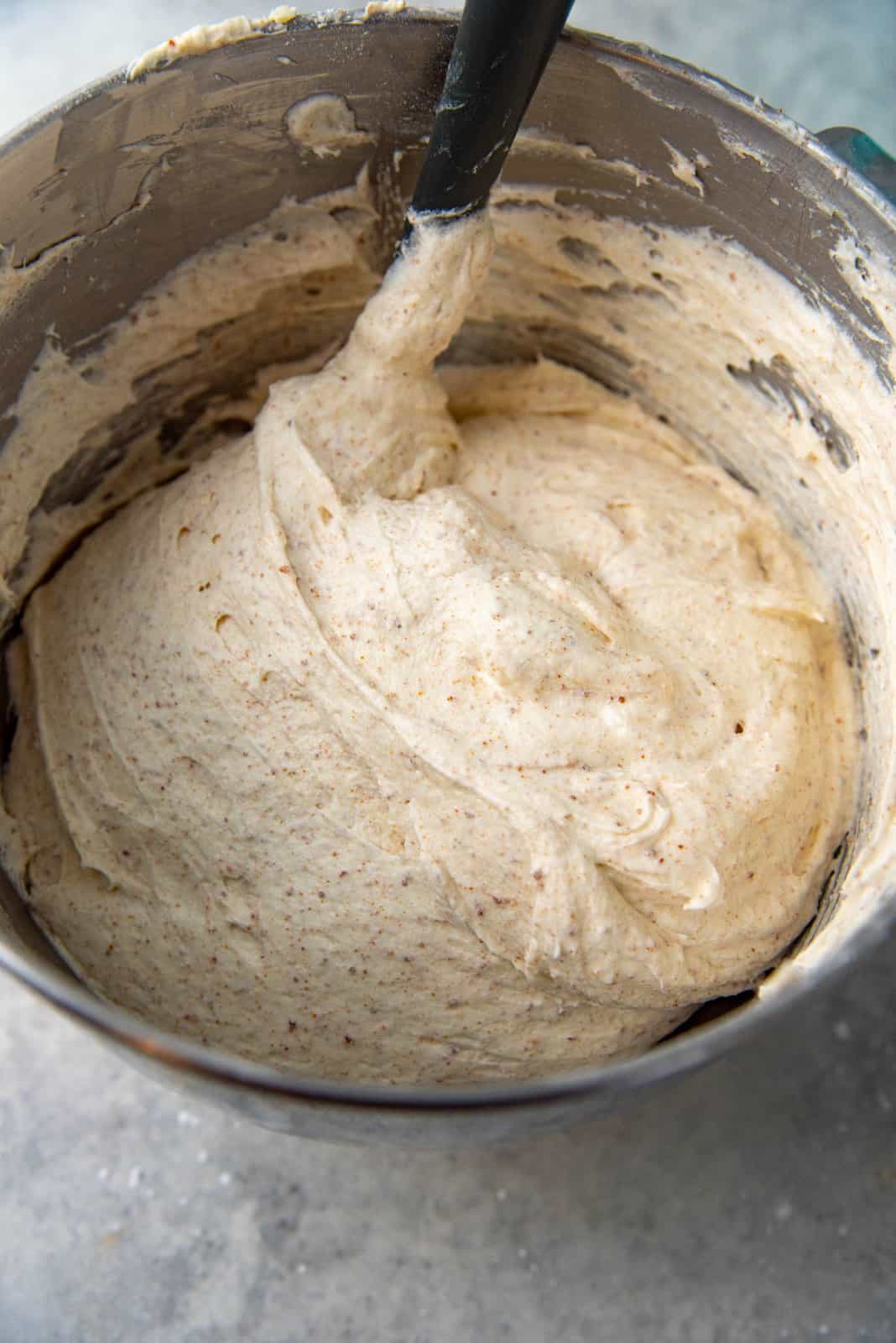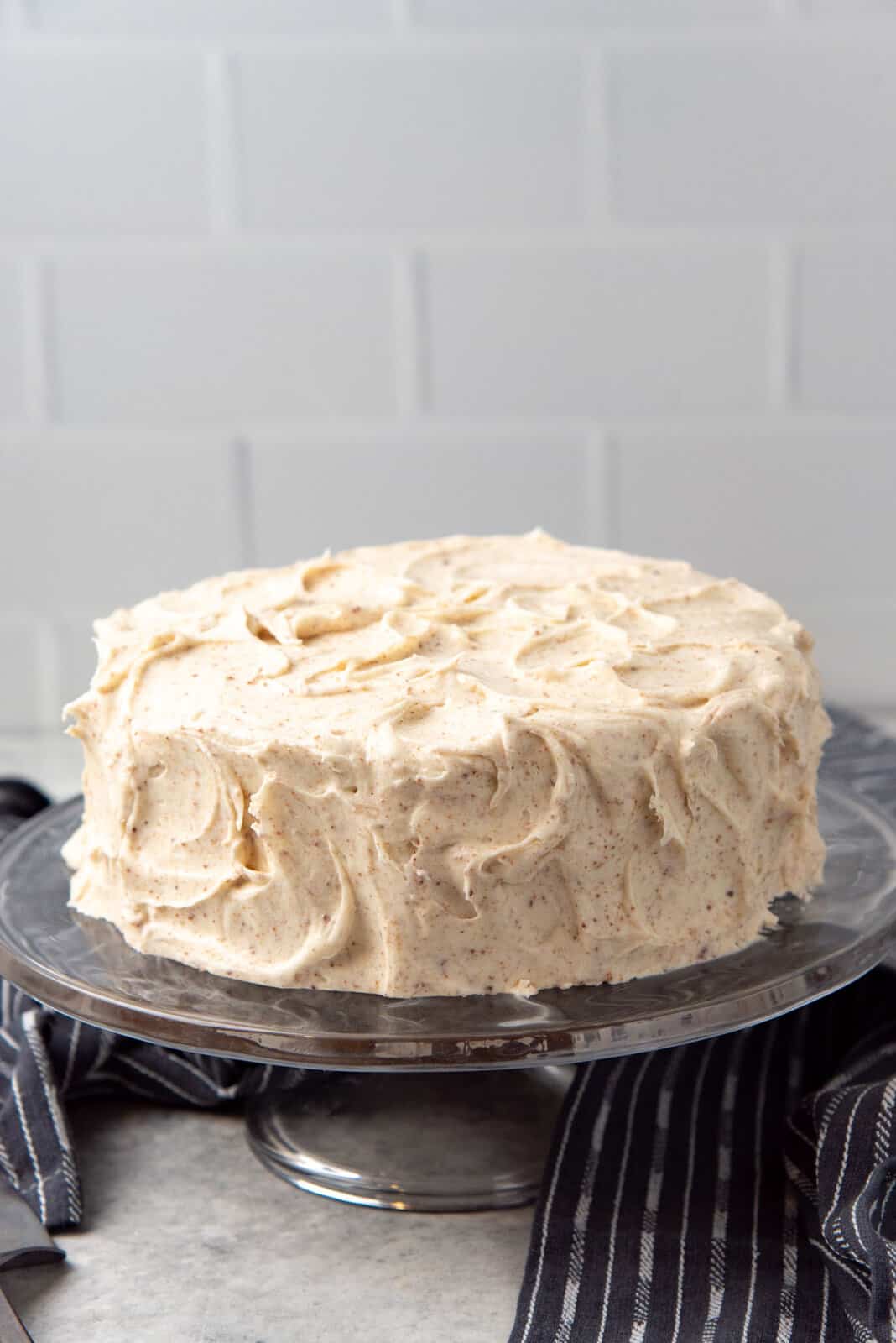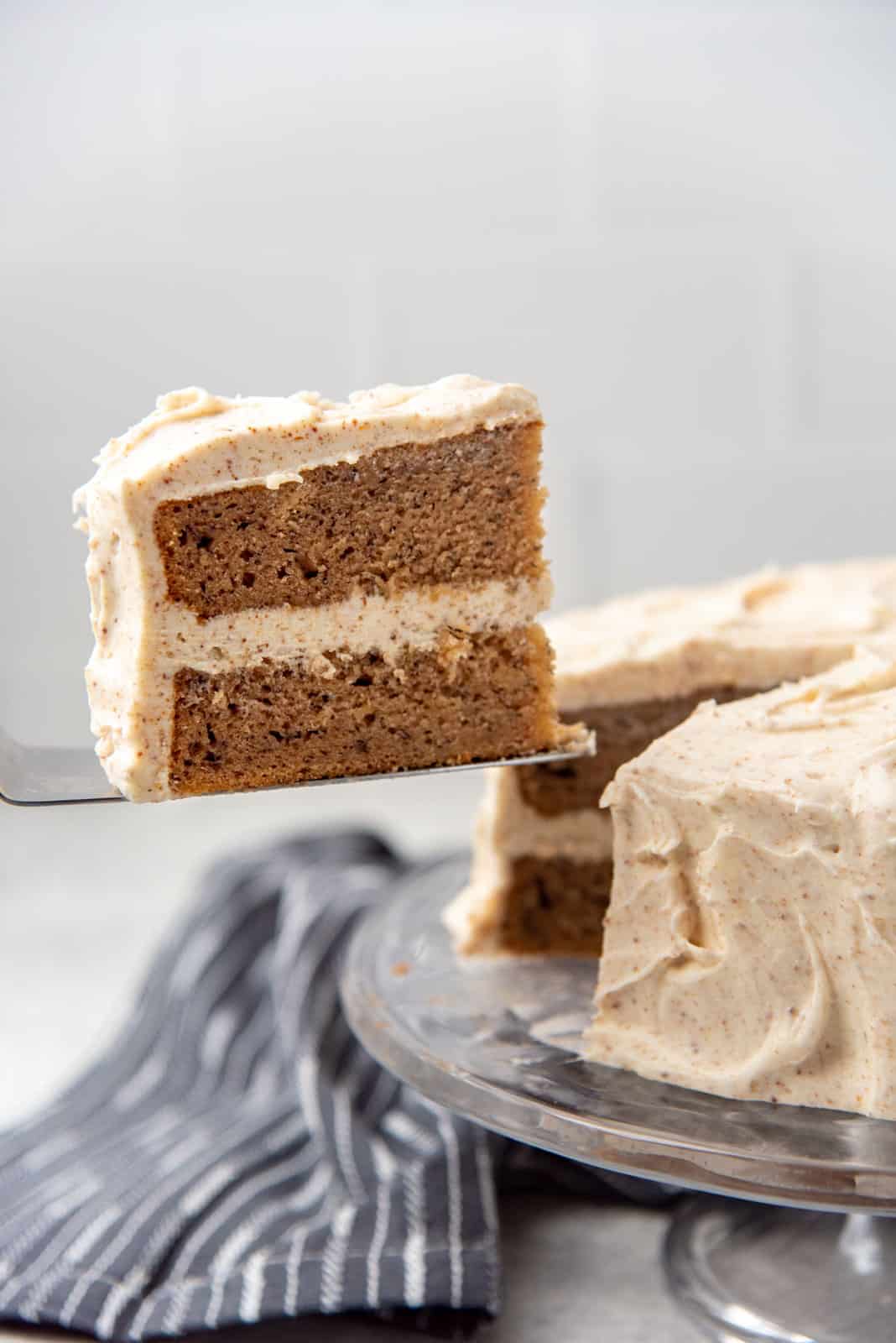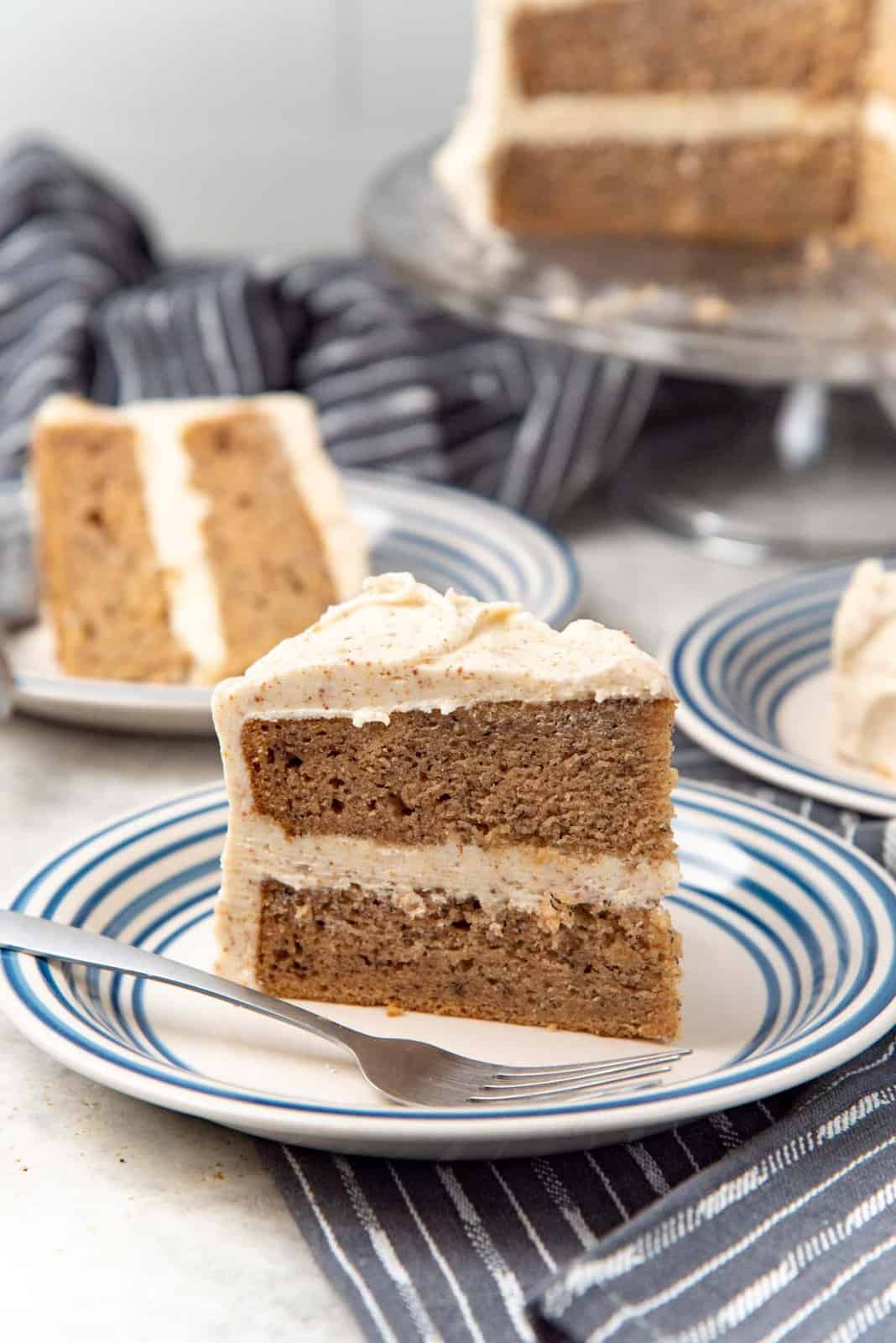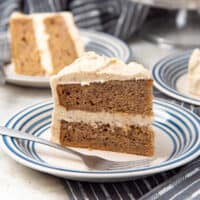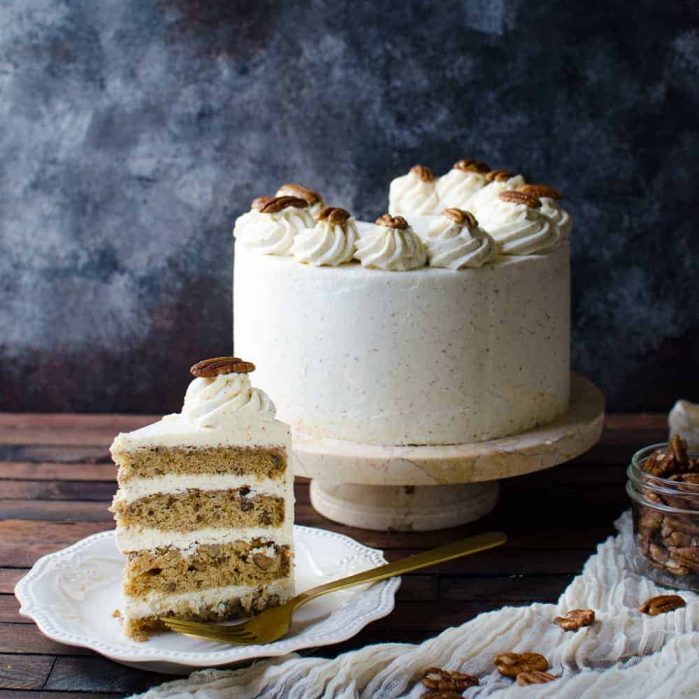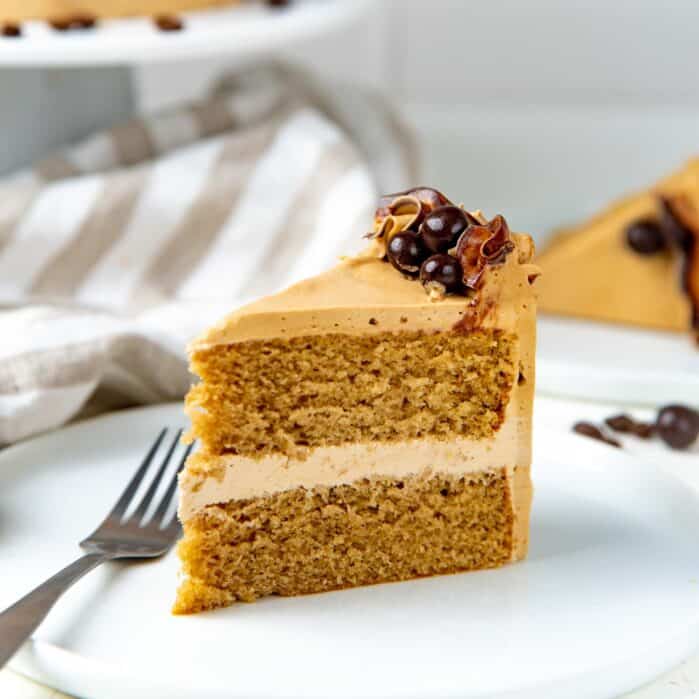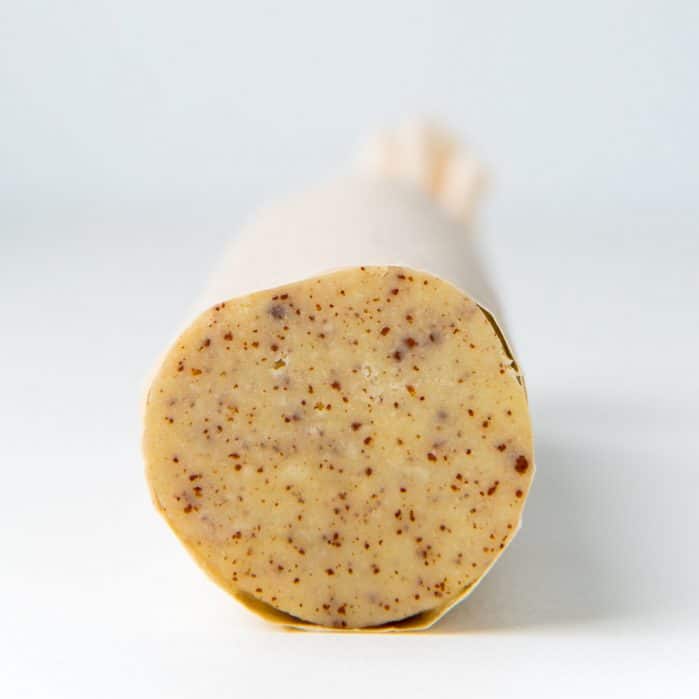This old fashioned homemade banana cake gets an upgrade with an ever more flavorful twist on my classic cream cheese frosting recipe. Plus, it’s so easy to make too. If you’re one of those delightful people who buys bananas just to make banana bread or banana cake, then you’re in the right place, with the right company! 🙂 I do that all the time too. And this banana cake is by far the best thing you can bake with your overripe bananas. Sure, you can absolutely make a banana sheet cake, or banana bread, or banana cupcakes, or even banana pudding – but this cake…. is something else. Making a layered cake somehow makes the cake that much more special, but it’s the brown butter cream cheese frosting that elevates this cake to a whole new level. I love brown butter in any frosting, but do you find brown butter cream cheese frosting to be too soft? Sure, you can add more confectioner’s sugar, but then the frosting is so sickeningly sweet. But I’ll show you how to make perfectly spreadable, amazing brown butter cream cheese frosting that is not too sweet, and not runny or too soft!
Why I love this layered banana cake recipe
Super simple to make. You don’t need a mixer for this recipe because the batter comes together so easily, but you can use one if you’d like to. You can make this as a 2 layer cake OR a 3 layer cake as well. The cake is incredibly soft, sweet but certainly not too sweet, and very moist (thanks to the overripe bananas!). The brown butter frosting! This is the BEST cream cheese frosting you’ll ever taste AND it’s not runny either, thanks to a “not-so-secret” technique.
Ingredients to make banana cake
Overripe bananas Butter and oil Brown sugar White sugar All purpose flour Baking soda Buttermilk Eggs Flavoring and spices (cinnamon)
Overripe bananas
The best type of bananas for this recipe is overripe bananas. The ones that have dark black spots, and a little squishy. If you have bananas that are still mostly yellow and firm to the touch, they need to be left longer to ripen further.
What if I don’t have overripe bananas?
You can ripen bananas in the oven by letting them “bake” at 300 F until the skin blackens and the bananas soften. While this technique does work, it won’t be the same as naturally overripened bananas because the sweetness level won’t be the same. But it will work in a pinch.
Butter and oil
This is the fat component in the cake. I use butter to add flavor to the cake. Making cake batter with oil results in a very light crumb in the cake, so I prefer to use a mix of both. You can also use margarine instead of butter as a substitute.
Brown sugar and white sugar
Both brown and white sugar are added to add moisture and sweetness to the cake, resulting in a very soft cake. Additionally, the brown sugar also adds a molasses-like flavor to the cake.
Buttermilk
The acidity of the buttermilk is needed to activate the baking soda in this banana layer cake recipe. If you don’t have buttermilk, then you can use these substitutes,
1 cup regular milk + 1 tbsp vinegar 1 cup plant based milk + 1 tbsp vinegar
The vinegar used can be apple cider vinegar, or white wine vinegar, or white vinegar.
What kind of frosting is best for an old fashioned banana cake?
Honestly, any type of frosting could be paired with any banana cake, including this banana layer cake. If you like the combo of banana and chocolate, then you could go with a chocolate buttercream frosting, or chocolate swiss meringue buttercream frosting. Or you could keep it simple with an vanilla buttercream frosting or swiss meringue buttercream frosting. But the classic frosting for banana cake is a delicious, creamy, tangy, and light cream cheese frosting. The same frosting that pairs so well with carrot cake and red velvet cake. Here, I made my classic cream cheese frosting recipe even better by adding brown butter, and that’s what we are doing here. And instead of just one layer of this delicious frosting, you get to have TWO layers of brown butter frosting for this banana layer cake!
The problem with adding brown butter
Butter that has been turned into brown butter is noticeably softer than regular butter. So the resulting buttercream will also be soft. Since cream cheese frosting is already a very soft buttercream, adding brown butter will make it runny and too soft. It’s harder to spread this like a regular buttercream, and it flows more like a thick glaze. But I have found a way to avoid this problem, while still adding brown butter to this buttercream!
How to make brown butter
Making brown butter is super easy. You just have to cook butter over medium heat while stirring. The butter will go through the stages of melting, bubbling, separation of solids and oil, and then finally the caramelization of the milk solids. I already have a detailed article I wrote about how to make brown butter, and the different stages of brown butter. The flavor of brown butter is mostly in the caramelized milk solids. The secret to increasing the milk solids (or what I like to call “flavor dust”!), is to add milk powder to the melting butter. Milk solids are essentially dried milk. So by adding some dried milk powder to the butter, you can create MORE caramelized milk solids in the butter. I used this techniques for my brown butter butterscotch mousse, and it makes the flavor even better.
Ingredients for the brown butter frosting
For this brown butter cream cheese frosting you will need,
Cream cheese – Make sure it’s the brick cream cheese, and NOT the kind that comes in tubs. Butter – I prefer unsalted, but you can use salted butter as well. Milk powder – This is the “secret ingredient”. You can leave it out, but the resulting buttercream will be softer. I use full fat milk powder, but you can use non-fat milk powder too. Confectioner’s sugar – Also know as powdered sugar. Salt – I don’t make any frosting without salt! It helps to balance the flavor. Vanilla – For a classic flavor, use a good quality vanilla extract or vanilla bean paste. You can use vanilla essence, but use less to avoid a bitter aftertaste.
How to make the banana layer cake
In a large bowl, mash up the overripe bananas with a fork, OR with the beaters of a hand mixer, or paddle attachment of your stand mixer. You do not have to mash the banana into a smooth paste. Some chunks are absolutely OK. These chunks will continue to break up as you make the batter. In fact, leaving chunks is recommended. Next, add the white sugar and brown sugar, along with the salt, to the mashed bananas. Stir to mix. Next, add the melted butter and oil. Whisk to combine. The eggs are added next. Whisk well to make sure the eggs are mixed well into the batter. Whisk in the cinnamon, buttermilk and vanilla. You can also add other spices such as pumpkin pie spice or gingerbread spice, but I only add cinnamon because I want the banana flavor to be front and center in the cake. Finally, add the flour and baking soda mix in two additions. Gently fold the flour mix into the batter with a rubber spatula. If you overmix the flour, you could end up with cake layers that have a rubbery texture, or a cake with large holes (also known as tunneling). Once the flour is folded in, divide the batter between two cake pans. Bake the banana cake batter in a preheated oven until the cake layers are baked through. The cake is baked through when a toothpick inserted comes out with just a few dry cake crumbs. This ensures that the cake isn’t over-baked or dry. Let the cakes cool in the cake pan for a few minutes, until the cake pans are warm to the touch. Flip the cakes over onto a wire rack, so that they can cool completely. This will prevent the cakes from getting soggy from condensation. Second method – Use a large cookie scoop (if the cake batter is thick), or ladle (if the cake batter is thin). Equally portion the batter into the cake pans using the scoop or ladle. Alternate between the cake pans until all of the batter is used up. When the cake layers have cooled down, they are ready to be frosted. You could store them until the next day at this stage as well.
To store the unfrosted cake layers for later
Wrap each banana cake layer in plastic wrap. If you live in a fairly cold climate, they can be kept outside for 24 hours. However, I prefer to keep them in the fridge until you’re ready to frost them. These layers can be kept in the fridge for up to 48 hours, or in the freezer for up to 2 months.
How to make brown butter cream cheese frosting
How to make brown butter “flavor dust”
Melt 1/4 cup of the unsalted butter in a small saucepan. After the butter melts, add the dry milk powder and stir in to mix. Keep heating the butter and milk mixture while whisking frequently. The butter will start to bubble as the water evaporates and the milk solids separate. Keep stirring and cooking the butter until the separated milk solids (and the dry milk powder) turn from white to yellow to a dark golden brown in color. When the milk solids have caramelized, transfer them into a bowl and let it cool down to room temperature. You can also do this the night before.
Making the cream cheese frosting
Make sure all the ingredients are at room temperature. In a mixer bowl, place the cream cheese, unsalted butter, browned butter, and salt. Mix the cream cheese and butter mix for about 3 – 5 minutes on medium speed, using the wire whisk attachment. The cream cheese and butter should become white, fluffy, and creamy. Make sure to scrape the sides of the bowl so that all of the ingredients get beaten uniformly. Since the recipe still contains unsalted butter in addition to the brown butter “flavor dust”, the texture of the frosting will never be compromised, and will be exceptionally spreadable and flavorful on your banana layer cake! When the cream cheese mix has become light and fluffy, lower the speed of the mixer to the lowest speed. Add the confectioner’s sugar, a portion at a time, to prevent the sugar from flying off everywhere as it mixes into the cream cheese. After all the confectioner’s sugar has been added and mixed in well, increase the speed of the mixer. Whisk the frosting until it’s light and fluffy again. Again, make sure to intermittently scrape the sides and bottom of the bowl with a spatula to make sure the brown butter cream cheese frosting is uniformly mixed and is fluffy. Add vanilla and mix for a further 2 minutes. You could add a little more confectioner’s sugar as well if you like, but I prefer the ratio of butter/cream cheese to confectioner’s sugar in my recipe.
How to assemble the cake
If the cake layers have a dome on top, you can use a bread knife to slice off the dome and make the surface more even. Place one layer of the cake on a flat plate or turntable. The bottom of the cake layer should be placed on the surface. Spread a layer of frosting on top – the thickness of this layer is up to you, but I personally prefer a 3/4 – 1 cm thick frosting layer because the cake layers are fairly tall. Once the middle frosting layer is evenly spread, place the second cake layer on top. To have an even top layer, place the 2nd cake layer with the smooth, bottom side facing up.
Crumb coating
If you want a cake with lovely smooth sides, then you must have a smooth crumb coating on your cake layers. However, if you want your banana cake to have an old fashioned / classic look, then you can absolutely skip this crumb coating layer for convenience.
A crumb coating in a thin layer of frosting that is spread all over the layered cake. The purpose of a crumb coating is to make the cake look smooth, even, and straight from the sides and top, as well as to stick any crumbs to the cake, so that you don’t have any loose crumbs. Consequently, the final frosting layer will have a perfect canvas to go on, AND there is no risk of loose crumbs getting in that final frosting layer, keeping the buttercream clean.
Once you have crumb coated your banana cake with a little of the brown butter cream cheese frosting, refrigerate the cake just until the frosting sets and hardens a little. You can also leave it in the fridge overnight if you like, and frost it on the day that you’re serving the cake.
Frosting the cake
When the crumb coating has set, spread a generous layer of brown butter cream cheese frosting all over the cake layers. Use a buttercream smoother or bench scraper to create smooth sides on the cake, while scraping off excess frosting. However, I went with a more rustic look here because I wanted my banana cake to have that old fashioned, classic bakery style feel. So I used a small offset spatula to create big swooping swirls in the frosting. I love that this is super easy to do, and less time consuming. Plus, it could also act to hide any imperfections in the cake (like a lopsided cake for example). However, what puts the icing on the cake (so to speak) is that I find the look and feel of this banana layer cake very nostalgic, reminding me of the homemade banana cakes that I enjoyed growing up!
Tips and tricks for this banana layer cake recipe
Make sure all the ingredients are at room temperature! This will make it easy to mix the ingredients for the batter and the frosting. Do not overmix the cake batter after adding flour. The gluten in the flour can make the cake rubbery, and the cake will no longer be soft, and might even end up being gummy. Make sure the baking soda is not expired. If the cake doesn’t rise in the oven, you will end up with dense, gummy banana cake layers. Divide the batter between the cake pans evenly so that you have cake layers that are the same height. While I didn’t do this for this recipe, you can use bake even strips (soaked in water), to help the cake layers bake with a nice and flat surface. This way you don’t need to slice off any domes on your cake later. Use dry milk powder to make “cheat’s” brown butter! This way you can get plenty of brown butter flavor without compromising the texture of the final cream cheese frosting.
I love to make this as a single layer sheet cake or as a layer cake, and the results are always spectacular! And be warned, this banana layer cake is pretty hard to refuse. You’ll be reaching for that second slice before you even realize it! 🙂

